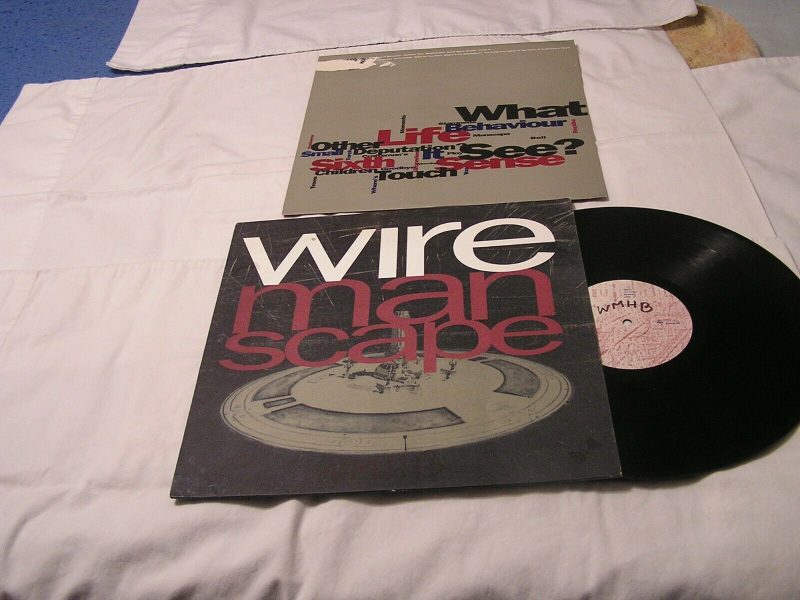Wire Vinyl Records Lps For Sale
Check out these new and used Wire vinyl records LPs for sale. We recommend starting your Wire vinyl collection with the essential albums Pink Flag, Chairs Missing and 154. Our inventory is always changing, so check back often, or browse our list of vinyl records for sale from rock musicians.
154
Chairs Missing
31% OffDrums & Wires (200gm Vinyl)
12% OffWired
Silver/Lead
24% OffMind Hive
Quarter Stick Feast Of Wire - 20th Anniversary Deluxe Edition
A Bell Is A Cup
$97.99 (as of July 3, 2025 02:56 GMT +00:00 - More infoProduct prices and availability are accurate as of the date/time indicated and are subject to change. Any price and availability information displayed on [relevant Amazon Site(s), as applicable] at the time of purchase will apply to the purchase of this product.)Wired (Mov Version)
8% OffLife In The Wires
11% Off
Wire: Unraveling the Sonic Tapestry
Origins and Early Days
Wire, a seminal post-punk band hailing from London, England, emerged in 1976 amidst the vibrant punk rock scene. The founding members – Colin Newman (vocals, guitar), Graham Lewis (bass, vocals), Bruce Gilbert (guitar), and Robert Gotobed (drums) – quickly gained attention for their unconventional approach to music. Wire’s sonic palette defied easy categorization, blending punk energy with avant-garde sensibilities.
Pink Flag (1977): A Pioneering Debut
Pink Flag, Wire’s debut album released in 1977, stands as a landmark in the history of post-punk. With 21 tracks spanning a mere 35 minutes, the album is a concise and intense exploration of minimalist punk aesthetics. Tracks like “Three Girl Rhumba” and “12XU” became anthems of the burgeoning post-punk movement, showcasing Wire’s ability to craft infectious yet experimental music.
The brevity of the tracks on Pink Flag didn’t diminish their impact; instead, it heightened the intensity of the listening experience. The album’s influence extended far beyond punk, reaching into the realms of alternative rock, noise rock, and even art rock.
Chairs Missing (1978): An Evolution in Sound
Chairs Missing, Wire’s second album, marked a departure from the raw immediacy of Pink Flag. Released in 1978, the album showcased a more expansive and experimental side of the band. The incorporation of synthesizers and a broader sonic palette hinted at Wire’s willingness to push musical boundaries.
Songs like “Outdoor Miner” and “I Am the Fly” demonstrated Wire’s ability to craft intricate and atmospheric compositions, earning them recognition as pioneers of post-punk’s evolution into more avant-garde territory.
154 (1979): Maturation and Experimentation
The third studio album, 154, released in 1979, continued Wire’s trajectory into uncharted musical territory. Named after the number of shows the band had played to that point, the album delved further into experimentalism, featuring longer and more complex compositions.
“Map Ref. 41°N 93°W” and “A Touching Display” showcased Wire’s lyrical depth and musical sophistication. 154 marked the end of the band’s initial phase, as they embarked on a hiatus shortly after its release.
Wire’s Hiatus and Return
Following the release of 154, Wire went on hiatus, with members pursuing various solo and collaborative projects. The band’s absence from the music scene only fueled their mystique, and fans eagerly awaited their return.
In 1985, Wire reconvened with a slightly altered lineup, featuring Colin Newman, Graham Lewis, Robert Gotobed, and new member Margaret Fiedler on guitar. The albums released during this period, such as A Bell Is a Cup… Until It Is Struck (1988) and Manscape (1990), showcased a more polished and electronically influenced sound.
Late 20th Century and Early 21st Century Explorations
The late 20th century and early 21st century saw Wire continuing their musical explorations. Albums like Send (2003) and Object 47 (2008) demonstrated a renewed vigor, with the band incorporating contemporary production techniques while staying true to their experimental ethos.
Wire’s ability to adapt to changing musical landscapes without compromising their core identity solidified their status as enduring innovators.
Similar Bands: Echoes of Wire’s Influence
Numerous bands have drawn inspiration from Wire’s groundbreaking approach to music. The post-punk and alternative rock scenes owe a debt to Wire’s sonic experimentation. Bands like Gang of Four, The Fall, and Mission of Burma share a kinship with Wire in their ability to merge punk energy with avant-garde sensibilities.
Additionally, the influence of Wire’s minimalist aesthetic can be heard in the music of Sonic Youth, who, like Wire, pushed the boundaries of what punk and alternative rock could achieve.
Wire’s Influence on Avant-Garde and Experimental Music
Beyond the realms of punk and alternative rock, Wire’s influence extends into avant-garde and experimental music. The band’s willingness to experiment with structure, sound, and technology paved the way for artists exploring the fringes of musical expression.
Artists such as Radiohead, Nine Inch Nails, and even the electronic duo Autechre have acknowledged Wire’s impact on their work. The spirit of innovation that Wire embodied continues to reverberate through the ever-evolving landscape of experimental and electronic music.
Wire’s Legacy: An Ever-Evolving Sonic Tapestry
As Wire navigated the changing tides of the music industry and artistic landscape, their legacy remained one of perpetual innovation. The band’s ability to transcend genres, influence diverse musical movements, and continually reinvent their sound underscores their enduring significance.
From the raw intensity of Pink Flag to the expansive experimentation of 154 and beyond, Wire’s sonic tapestry is a testament to the power of artistic evolution. As the band persists in pushing the boundaries of their own creativity, their influence will undoubtedly continue to shape the landscape of alternative and experimental music for years to come.
Wire - Pink Flag [New Vinyl LP]
 | $28.16 Buy It on eBay for only: $28.16 Buy It Now on eBay |
Wire - Pink Flag [Used Very Good Vinyl LP]
 | $23.86 Buy It on eBay for only: $23.86 Buy It Now on eBay |
Wire - 154 [New Vinyl LP]
 | $28.20 Buy It on eBay for only: $28.20 Buy It Now on eBay |
Wire Nine X Seven (Vinyl) 12" Album (UK IMPORT)
 | $43.00 Buy It on eBay for only: $43.00 Buy It Now on eBay |
Wire 154 VINYL Record LP LA Misprint Variant Post Punk Original Press
 | $39.99 End Date: Sunday Jul-06-2025 17:07:22 EDT Buy It on eBay for only: $39.99 Buy It Now on eBay |
Wire - "154" LP - Warner Bros Records BSK 3398 - 1979 First US Pressing
 | $49.99 Buy It on eBay for only: $49.99 Buy It Now on eBay |
WIRE - NINE SEVENS - RSD 2025 VINYL Record Store Day New Sealed
 | $38.00 (1 bid) End Date: Monday Jul-07-2025 15:03:53 EDT Bid |
Wire - Chairs Missing [New Vinyl LP]
 | $28.18 Buy It on eBay for only: $28.18 Buy It Now on eBay |
Wire – PF456 Deluxe 2LP 10” Vinyl + 7” RSD 2021 Hardback Book
 | $89.99 Buy It on eBay for only: $89.99 Buy It Now on eBay |
Original 1979 Wire "154" import LP - EMI Records (SHSP-4105) [made in U.K.] NM+
 | $120.00 Buy It on eBay for only: $120.00 Buy It Now on eBay |
WIRE 154 EMI EMS81277 JAPAN VINYL LP
 | $67.89 Buy It on eBay for only: $67.89 Buy It Now on eBay |
LP, Wire - Pink Flag Harvest ST-11757 w/warning 1977 VG++/NM Post Punk
 | $70.00 Buy It on eBay for only: $70.00 Buy It Now on eBay |
ALBERT KING Live Wire/Blues Power STAX LP c
 | $8.00 (2 bids) End Date: Monday Jul-07-2025 17:53:07 EDT Bid |
Wire – Dot Dash / Options R 1978 UK 45 HARVEST 1st PRESS Original
 | $49.00 Buy It on eBay for only: $49.00 Buy It Now on eBay |
Vinyl Wire Train LP Between Two Words 1985 Shrink NM
 | $19.96 Buy It on eBay for only: $19.96 Buy It Now on eBay |
Wire 154 1979 Uk Harvest Vinyl 7" 45 Single EP Psr 444 free EP
 | $40.95 Buy It on eBay for only: $40.95 Buy It Now on eBay |
NEW: WIRE - Chairs Missing, Vinyl LP
 | $24.98 Buy It on eBay for only: $24.98 Buy It Now on eBay |
Change Become Us by Wire (Sealed & New)w/minor sleeve damage
 | $30.57 Buy It on eBay for only: $30.57 Buy It Now on eBay |
WIRE Dot Dash 7" ep 1978 Harvest records punk rock alternative see pics
 | $4.00 End Date: Thursday Jul-10-2025 23:00:01 EDT Buy It on eBay for only: $4.00 Buy It Now on eBay |
AC/DC TOUCH TOO MUCH LIVE WIRE IMPORT FRANCE
 | $17.00 Buy It on eBay for only: $17.00 Buy It Now on eBay |




![Batterie et [Vinyl LP] ABIS_MUSIQUE Communication musicale Galilée](https://m.media-amazon.com/images/I/519hM1rDAeL._SL160_.jpg)



















![Back to Black [Vinyl] #1](https://m.media-amazon.com/images/I/61Db7-hQGKL._SL100_.jpg)

![Legend [Vinyl] #1](https://m.media-amazon.com/images/I/611La+6Hi9L._SL100_.jpg)
![Legend [Vinyl] #2](https://m.media-amazon.com/images/I/31nfAYBov8L._SL100_.jpg)
![Legend [Vinyl] #3](https://m.media-amazon.com/images/I/21h7ykrSuuL._SL100_.jpg)
![Legend [Vinyl] #4](https://m.media-amazon.com/images/I/318kzRTVolL._SL100_.jpg)
![Legend [Vinyl] #5](https://m.media-amazon.com/images/I/31vjgY6+u5L._SL100_.jpg)




![[Exquisite Appearance] Built from wood and metal materials with a unique sense of layering; The streamlined corner design is truly atmospheric and stylish(Note: long hold the start button to turn the power on, and press again to start) [All in 1] Thi...](https://m.media-amazon.com/images/I/41vovGjFkeL._SL160_.jpg)






































